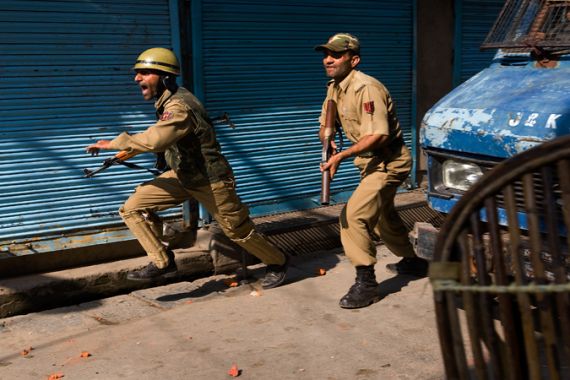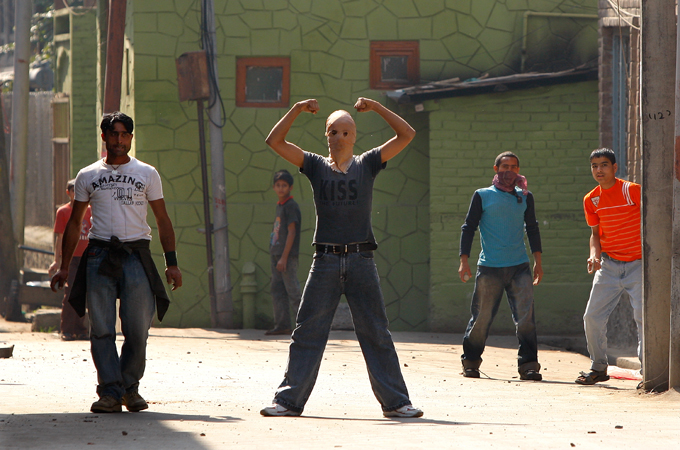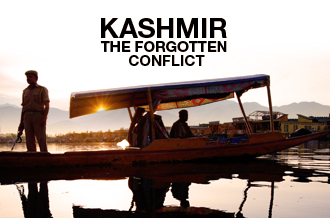The evolution of Kashmiri resistance
From pro-Independence to pro-Pakistani militia, the new generation of Kashmiri youth abandoned Kalashnikovs for stones.

 |
| A new generation of resistance has chosen stones instead of Kalashnikovs as its weapon of choice [GALLO/GETTY] |
Twenty years ago, in the summer of 1991, the Kashmir Valley was in the grip of full-fledged insurrection.
Hordes of young, Kalashnikov-wielding men roamed the streets and neighbourhoods of Srinagar, the capital, and the valley’s other towns like Baramulla, Anantnag and Sopore. The sound of gunfire and explosions mingled with chants of “azaadi” [“freedom”] emanating from demonstrations large and small. People from all strata of society took part in protests against Indian rule.
The organisation leading this movement was the Jammu and Kashmir Liberation Front (JKLF), which believes in a sovereign Kashmir, independent from both India and Pakistan, and whose tricolour flag bears a significant resemblance to the Palestinian national colours.
Indian security forces, led by federal paramilitary police units flown in by the central government in New Delhi, fought a desperate battle to stem the tidal wave of insurgency and popular uprising sweeping the valley.
Fifteen years ago, in the summer of 1996, the situation on the ground was very different from what it had been just a few years previously. The insurrection had lost strength and momentum. The Indian security forces had regained control over Srinagar and other major towns. The JKLF, exhausted and broken as an organisation, had ceased to be active in the armed struggle.
Its position as the dominant group in the insurgency had been taken by the Hizb-ul Mujahideen (HM), an organisation with a pro-Pakistan ideology. The insurgency was in disarray – hundreds of young men active as insurgents during the first half of the 1990s were switching sides and joining with Indian security forces as valued auxiliaries in combating a significantly weaker insurgent campaign dominated by HM.
What happened to produce such a sea-change between 1991 and 1996?
|
The tenacity and ruthlessness of the Indian counter-insurgency campaign had taken a heavy toll on the insurgents’ morale and capacities. Between 1990 and 1994, the peak years of the armed struggle, 5,119 were killed and thousands more captured.
The Kashmiri writer Agha Shahid Ali captured the essence of this period: “Srinagar hunches like a wild cat; lonely sentries, wretched in bunkers on the city’s bridges, far from their homes in the plains, licenced to kill … while the Jhelum [river] flows under them, sometimes with a dismembered body. On Zero Bridge the jeeps rush by … guns shoot stars into the night, the storm … rages on … night after night … son after son taken away, never to return from the night of torture.”
The toll taken by the Indian counter-offensive was gravely exacerbated by disunity and infighting in the insurgent ranks. The two largest insurgent groups, JKLF and HM, subscribed to different and conflicting visions of Kashmiri “self-determination”.
Kashmir: Independent or Pakistani?
The JKLF’s slogan, Kashmir banega khudmukhtar [‘Kashmir will be sovereign’] stood in contradiction to the HM’s – Kashmir banega Pakistan [“Kashmir will be part of Pakistan”]. The latent fissure in the azaadi movement steadily deepened and turned toxic.
Starting from 1991, the Pakistani military’s Inter-Services Intelligence (ISI) – which had been providing lethal weapons and training to the Kashmir insurgency since the its nascent phase in the late 1980s – cut off aid to the JKLF and engineered splits and defections in the pro-independence camp while building up the HM with a programme of all-out support.
|
“Srinagar hunches like a wild car; lonely sentries, wretched in bunkers on the city’s bridges, far from their homes in the plains, licesnsed to kill…while the Jhelum [river] flows under them, sometimes with a dismembered body.” Agha Shahid Ali, Kashmiri writer |
The HM then embarked on a campaign of killing pro-independence fighters and assassinating prominent pro-independence political and religious figures.
This strategy of bringing the Kashmir insurrection under Pakistani control boomeranged in India’s favour. From the 1940s until today, pro-independence sentiments have been dominant among the Kashmir Valley’s people, and the pro-Pakistan view has been the preserve of a small, though dedicated, minority.
In the mid-1990s a severe backlash developed in the valley against the HM and its Pakistani sponsors. By 1996, public disillusionment with the prospects of the uprising and the “gun culture” it had spawned was becoming widespread, and numerous erstwhile insurgents belonging to JKLF and other groups were either downing arms or seeking protection from and vengeance against HM, through active collaboration with the Indian counter-insurgency apparatus.
A lethal combination of Indian repression and Pakistani manipulation thus brought a close to the most spontaneous and popularly backed phase of the azaadi movement. But that did not signal an end to the cycle of strife and violence.
Ten years ago, in the summer of 2001, an atmosphere of acute tension and fear prevailed in the Kashmir Valley. That year marked the high point of a concerted campaign of “fidayeen” attacks, targeting a variety of Indian official installations in the valley – mostly army and paramilitary camps and police headquarters – that began in 1999 and occurred frequently until 2003, and sporadically thereafter.
These were typically suicide raids carried out by two-man teams who would force their way into the premises concerned while firing assault rifles and lobbing grenades, and who would then engage in protracted stand-offs with the security forces until eliminated. In a few instances the attackers used cars packed with explosive, but usually they came on foot.
The fidayeen phase
Between mid-1999 and the end of 2002, at least 55 such attacks took place and 161 military, paramilitary and police personnel died, as did 90 perpetrators. The relatively small number of fatalities does not capture the psychological impact at the time of the fidayeen campaign, both on the Indian security establishment and the population at large. The single largest number of attacks – 29 – took place in 2001.
The fidayeen phase of the Kashmir insurgency was not the brainchild of Kashmiris. The large majority of fidayeen assaults were carried out by the Lashkar-e-Taiba (LeT), an organisation of religious radicals founded and headquartered in Pakistan and led by Pakistanis. Almost all of the remainder were the work of the Jaish-e-Mohammad (JeM), a similar – albeit much smaller – Pakistani group.
The LeT entered the Kashmir war in the mid-1990s as part of an ISI strategy of having cadres of trusted Pakistani radical groups infiltrate the Kashmir theatre of operations. In the early through mid-1990s, the Kashmiri insurgent ranks consisted almost entirely of locals.
In 1991, for example, of the 844 insurgents killed, all but one were natives of Indian-administered Kashmir. By the late 1990s, the insurgency, active by that time mainly in rural areas with mountainous terrain or forest cover, consisted of a mix of locals and Pakistani religious radicals.
The fidayeen offensive commenced just after a limited military conflict in the summer of 1999 between India and Pakistan on a remote sector of the 742-kilometre Line of Control (LoC) dividing Jammu and Kashmir between the two countries, after Pakistani military units crossed the Indian side of the LoC near the town of Kargil in the high Himalayas – and were eventually forced to withdraw after fierce fighting and an international diplomatic crisis.
The Lashkar-e-Taiba did, over time, recruit a handful of local Kashmiris as a fidayeen cadre. But the large majority of those who executed these attacks were Pakistanis – most from Pakistan’s Punjab province – who had crossed the de facto border between Pakistani-administered and Indian-administered Kashmir.
Violence spills into India
In December 2001, as fidayeen attacks peaked in Kashmir, five heavily armed gunmen attempted a similar assault on India’s national parliament in New Delhi. They were only just prevented by vigilant security staff from entering the parliament building, where hundreds of parliamentarians and ministers were present, and were killed in the portico of the building after a 45-minute gunfight.
Had they succeeded in entering the building, carnage and crisis of unprecedented proportions would have resulted. The Indian government alleged that these five men were Pakistani extremists, and war clouds engulfed the subcontinent for most of 2002.
In November 2008, the LeT carried out the infamous attack on Mumbai, killing 166 people, using – in a more indiscriminate variant – the technique honed in Kashmir from 1999 onwards.
Five years ago, in the summer of 2006, the Kashmir Valley was calmer than it had been at any time during the previous fifteen years. During and after the India-Pakistan crisis of 2002, General Pervez Musharraf – chief architect of the 1999 Kargil conflict – came under pressure from the United States to curb the Pakistani military’s support for Pakistani radical groups active in Kashmir, especially the LeT.
The Pakistani military’s relationship with their country’s radical Islamist spectrum also soured progressively after September 11, 2001, due to the renewed nexus between the military hierarchy and the United States.
The effect in Kashmir was significant.
Fidayeen attacks fell off steeply after 2003, and the influx of insurgents from the Pakistani side of the LoC also declined sharply. The LeT and smaller groups of “jihadi” persuasion retained a presence in Kashmir – as they still do – but the offensive posture of 1999-2003 yielded to a low profile.
|
|
The Hizb-ul Mujahideen, a group much more indigenous to Kashmir than the LeT, has been steadily weakened since the mid-1990s by a long war of attrition with the Indian security forces as well as by internal divisions. Its capabilities drastically curtailed, the HM too adopted a low profile.
By 2006, the insurgency in Kashmir declined to a trickle of incidents, limited to the rare car bomb and an occasional ambush, and the somewhat more frequent raids by Indian security forces on hideouts. Violence has fallen to even more negligible levels since then.
This is a far cry from two decades or even a decade ago – in 2000, for example, 1,612 insurgents were killed in fighting with the security forces. The Indian security forces remain ubiquitous – paramilitary and police personnel patrol the streets of urban centres and hold bunkers in sensitive locations, while army camps dot the countryside, and military convoys are a frequent sight on the valley’s roads.
But compared to the siege-like conditions of 1990-1995, or even the years of fidayeen warfare from 1999 to 2003, life in Srinagar is “normal” compared to twenty, fifteen or even ten years ago. But unrest simmers just under the surface.
A new generation of resistance
The summer of 2008 saw the valley’s largest demonstrations since 1994 against Indian authority, as hundreds of thousands joined rallies and marches.
Last summer, normal life in the valley ground to a halt from June through September, as tens of thousands of young stone-pelters confronted the security forces. More than one hundred were shot to death in the confrontations, and several thousand were injured.
The stone-pelters, some of whom used internet-based social media to organise, are predominantly teenage boys and young men in their twenties. In other words, they were either children or not yet born when Kashmir turned into a brutal warzone two decades ago, and have grown up in the environment described above.
Unlike their previous generation, who picked up the AK-47, this generation’s weapon of choice is the stone, but the sense of grievance is equally intense. Anger towards Indian authority is deeply rooted in the Kashmir valley, but the credibility of Pakistan is at an all-time low among the population, fuelled as much by the experience of the malign Pakistani role in Kashmir – over more than two decades – as by Pakistan’s precarious situation as a state.
Agha Shahid Ali expressed a hope for genuine peace in Kashmir: “We shall meet again, in Srinagar, by the gates of the villa of peace, our hands blossoming into fists, till the soldiers return the keys and disappear.”
That remains a forlorn hope.
The people of the Kashmir Valley know that their fate is not in their hands; it is in the hands of those who wield power in New Delhi, and in Rawalpindi. And Jammu and Kashmir consists of much more than the valley – Indian-administered Kashmir also contains the regions of Jammu and Ladakh, where the majority of people identify with India, while Pakistani-administered Kashmir’s population is vertically split between those who identify with Pakistan and those who aspire to independence.
Yet the sense of powerless born of this realisation is suffused with an enduring streak of defiance – a defiance fed by decades of suffering, trauma and tragedy.
Sumantra Bose is Professor of International and Comparative Politics at the London School of Economics. His books include Contested Lands: Israel-Palestine, Kashmir, Bosnia, Cyprus, Sri Lanka, and Kashmir: Roots of Conflict, Paths to Peace.
The views expressed in this article are the author’s own and do not necessarily represent Al Jazeera’s editorial policy.
